Cutting drywall can be difficult, messy, and time-consuming, especially if you’re using the wrong tool for the job. But how do you make the right tool choice?
If you are cutting a large hole in drywall, it may be easier for you to use a power tool, like a reciprocating saw, or an oscillating multi-tool. If you’re operating in a smaller area, such as cutting drywall for an outlet, you may opt for something lighter, like a utility knife or a keyhole saw.
Below, I’ve put together a list of some of the best ways to cut drywall and the tools you’ll need to get it done – each has its own pros and cons. Read on to find out where to buy the best tools, how to use them, and how to avoid mistakes before they happen when you’re cutting drywall for your next project.
Table of Contents
- What Are The 8 Best Tools For Cutting Drywall?
- How To Choose Which Drywall Tool Is Right For You
- Are There Extra Safety Precautions Necessary for Cutting Drywall?
- How Do You Hang Drywall?
What Are The 8 Best Tools For Cutting Drywall?
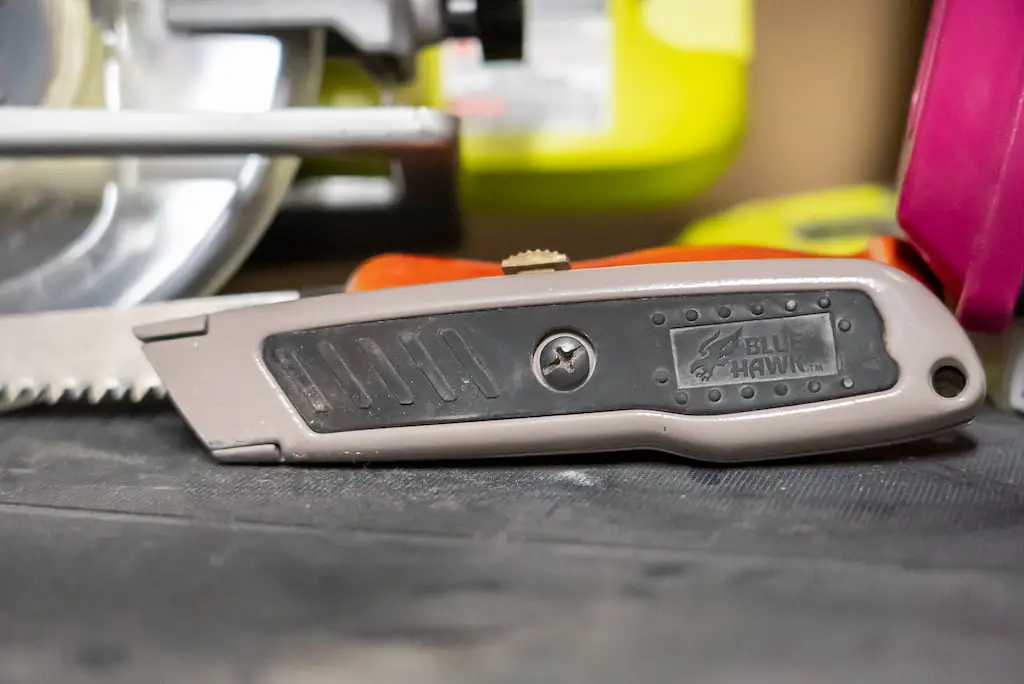
#1: Utility/Razor Knife
Pretty much every drywall job could benefit from a razor knife or utility knife – there’s nothing better for scoring a straight line on drywall, and then snapping it for a clean cut.
I just bought this one and have quickly fallen in love – it’s well built, feels good in the hand (even after long DIY projects), and the blades stay put, which is something I’ve struggled with in cheaper utility knives.
As with any project, measure twice (or three times, or four to be safe) and cut once. Drywall is messy, and the less dust you expose yourself to, the better.
When To Use A Utility Knife or Razor Knife to Cut Drywall
A good utility knife or razor knife is essential to nearly every drywall project – even if you aren’t sure you’ll need it, make sure you have one on hand.
What To Look For In A Utility Knife or Razor Knife to Cut Drywall
If you’re shopping for a utility knife or razor knife to cut drywall, you’ll want to look for:
- A super sharp blade, or replaceable blades
- An ergonomic handle – I like rubberized grips like this one
- A way to safely store the knife, either a retractible blade or a folding knife
- A sharp tip to help pierce
How To Use A Utility Knife or Razor Knife to Cut Drywall
The trick to using a utility knife or razor knife to cut drywall is to go shallow – only about 1/8″ deep or so.
Why? Because drywall is actually made up of gypsum powder sandwiched between two layers of heavy-duty paper, and you only need to cut through or score the paper to get a clean cut. In other words, there’s no reason to cut all the way through.
Once you’ve scored one side of your drywall, turn the board over and add some gentle pressure along the scoreline – it should cleanly break away.
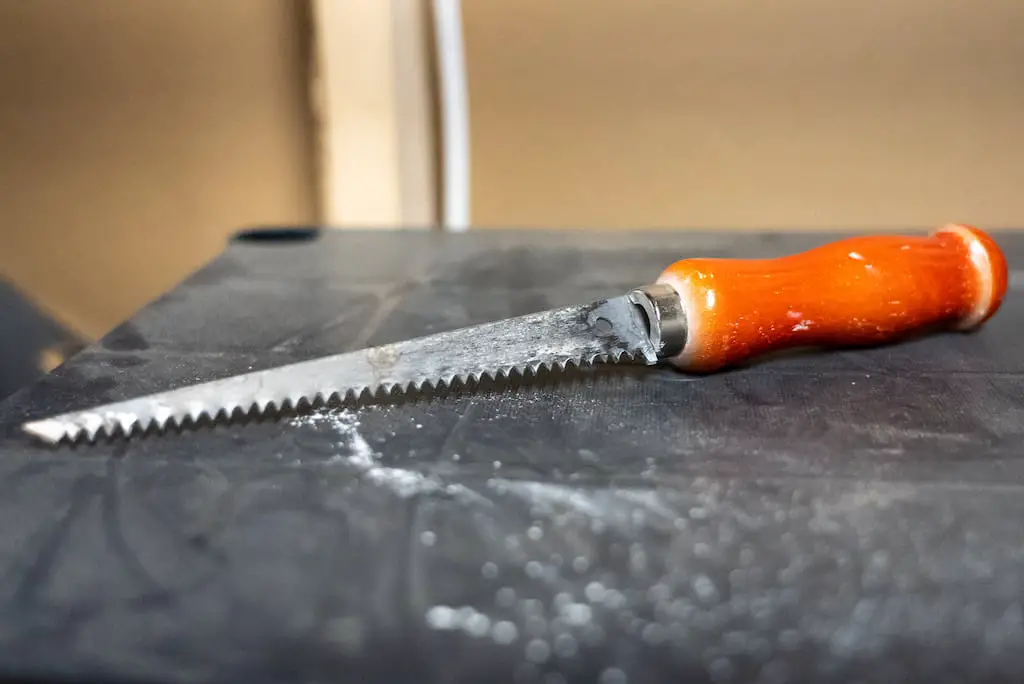
#2: Keyhole Saw, Compass Saw, Jab Saw, or Drywall Saw (Handheld Drywall Saws)
Also called a keyhole saw, a compass saw, or a jab saw, a handheld drywall saw is what I usually reach for when it comes time to cut through existing drywall. It usually leaves a pretty rough cut, but for small jobs, it’s almost never worth it for me to go searching for (yet another) power tool – the drywall saw gets it done.
When To Use A Handheld Drywall Saw
Because it’s a hand tool, I feel like I have lots of control and can quickly know if I’m coming in contact with something I shouldn’t be (wiring, pipes, etc).
If I was going to cut down larger sheets of drywall or cut through huge openings, I’d definitely reach for a power tool, but for 99% of my drywall needs, the simple drywall saw is perfect.
What To Look For In A Handheld Drywall Saw
When you’re choosing your handheld drywall saw, look for one that has a sharp and pointed tip, like this one. This will make it easier for you to get the saw into the drywall in the first place and can save you from having to drill a starting hole in the drywall for your saw.
You’ll also want to look for:
- An ergonomic handle (I bought the cheaper version with a terrible handle and will definitely upgrade if/when this one wears out)
- Sharp teeth
- A sharp, pointed tip for plunge cuts
- Some saws come with a rasp feature – that’s definitely a bonus!
How To Use A Handheld Drywall Saw
Much like a utility knife, a drywall or jab saw is great for small, straight cuts into drywall. That being said, it can do rough curved cuts, you’ll just have to be quite careful.
If you’re working with drywall that is already hung on your wall, make sure to be aware of how far you are inserting your saw into the wall – you definitely don’t want to poke through the other side!
The blades on most handheld drywall saws are longer than what you’d generally need. I’ve not used them, but I know you can also find retractable drywall saws, like this one, that allow you to extend the blade only as far out as you need for your project.
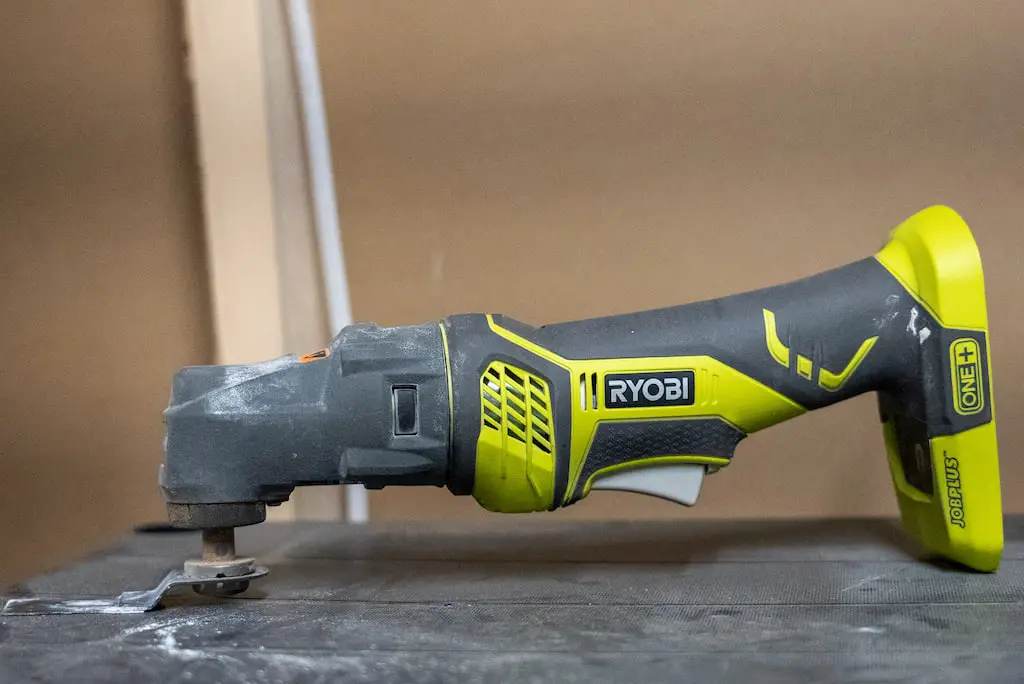
#3: Oscillating Multitool
Handheld tools like a utility knife or drywall saw are great – until you need to make a lot of cuts. If you have lots of smaller cuts and want to save time (and your aching hands!), an oscillating multi-tool like this one from Ryobi can do the trick – it’s the exact model I own (pictured above)!
PS: I LOVE Ryobi tools and recommend them to everyone I know – here’s why.
Multi-tools are great because they can do so many things – especially if you pick up a variety package of blades like this one. Many of the blades in that particular pack are rated for cutting through drywall, and I LOVE their universal fitment.
When To Use An Oscillating Multitool to Cut Drywall
While you could definitely cut long, stright lines with a multi-tool, I’ve found they work better for when you have a large volume of smaller cuts, especially plunge cuts. For example, if you were cutting out a bunch of holes in drywall for outlets, an oscillating multi-tool is a great tool for the job.
Another time that’s great for using a multitool is if you’re in cramped conditions – there’s really no other tool that can work in tight spaces like a multitool!
What To Look For In An Oscillating Multitool Cut Drywall
If you’re shopping for a multi-tool for drywall, you’ll also want to consider how you’ll use it for other projects. It’s versatility is what makes it one of the most useful tools in your collection!
Here’s what to look for when buying an oscillating multitool:
- Battery powered (so you aren’t tripping over extension cords or always searching for an outlet)
- Easily interchangable blades with a wide variety of blades/attachments available
- Good hand feel – if it’s uncomfortable to use, you’re not going to want to use it.
- If you think you’re going to use it A LOT, consider upgrading to the brushless model – it’ll work cooler and last a lot longer
How To Use An Oscillating Multitool To Cut Drywall
To use a multitool to cut drywall, align your blade with the mark of where you want to cut on your drywall. Then, slowly squeeze the tool to start cutting- faster is not better. Use as much speed as you need to get through the material, and no more.
As another tip, I’ve found that multitools have a tendency to ‘jump’ on me – use two hands to steady yourself and be ready to pull back if necessary. You don’t want to accidentally ruin a piece of drywall because your tool got away from you!
#4: Reciprocating Saw
Reciprocating saws are probably a little overpowered for drywall work, but they can certainly help you get the job done – especially if you use a specialty drywall blade like this instead of a normal reciprocating saw blade.
Actually, I’d avoid using a reciprocating saw on drywall unless you have that specific blade installed – the normal ones are way too aggressive for drywall use, and it’d be way too easy to cut through a stud, live wire, or pipe.
With that being said, still BE VERY CAREFUL when using reciprocating saws on drywall – there are tons of wires, boxes, pipes, etc. hidden behind each drywall panel that, if nicked or cut, can cause catastrophic damage.
When To Use A Reciprocating Saw to Cut Drywall
If you need to make a bunch of plunge cuts and you already own a reciprocating saw, a reciprocating saw is a great choice for drywall work (even if it is little overpowered).
What To Look For In A Reciprocating Saw to Cut Drywall
I wouldn’t buy a reciprocating saw just to cut drywall, but if you already have one on hand, purchasing a drywall blade can help you get even more use out of your existing tool.
You’ll want to look for:
- A short length (2.5 inches is usually a good choice) to help avoid nicking anything important behind the drywall
- A sharp front of the blade to help the tool plunge into the drywall
- Avoid teeth rated for wood – they’ll be way too aggressive.
How To Use A Reciprocating Saw To Cut Drywall
In order to use the reciprocating tool to cut drywall, make some guide marks using a pencil before you start. Hold your tool at a 90-degree angle to the wall, and the reciprocating saw should glide through the drywall like a hot knife cutting butter.
#5: Spiral Saw or Rotozip
Spiral saws are also referred to as Rotozips (even if they’re not made by that company) since Rotozip owns so much of the market. I basically think of them as mini routers.
If you’re planning a big drywalling job, a spiral saw can save you tons of time, especially when cutting openings like for an electrical box or hanging a light fixture.
When To Use Spiral Saw or Rotozip to Cut Drywall
If you want one tool to do pretty much all your drywall cuts, a spiral saw or Rotozip is the perfect choice. It’s great at plunge cuts, freehand cuts, cut-outs, circular cuts, and pretty much anything else. You’ll likely still want a good utility knife (like this one I mentioned above), but those two together make a great pair.
What To Look For In A Spiral Saw or Rotozip to Cut Drywall
When you’re looking to purchase a spiral saw or rotozip, here’s what you’ll want to look for:
- Cordless capability (unless you’re buying a Rotozip brand, then you’ll probably want to go corded since your existing batteries won’t work)
- Something that accepts 1/8 inch and 1/4 inch bits so you’re not limited to certain cutting applications
PS: If you’re planning to use your spiral saw to cut a hole for a recessed light fixture, I’d recommend getting something like this circle-cutting attachment to tackle those difficult circular cuts.
How To Use A Spiral Saw or Rotozip to Cut Drywall
The best tip I ever heard for using a sprial saw or Rotozip is to cut counterclockwise if you’re cutting around the outside of something and clockwise if you’re cutting around the inside of something – you’ll get cleaner cuts that way!
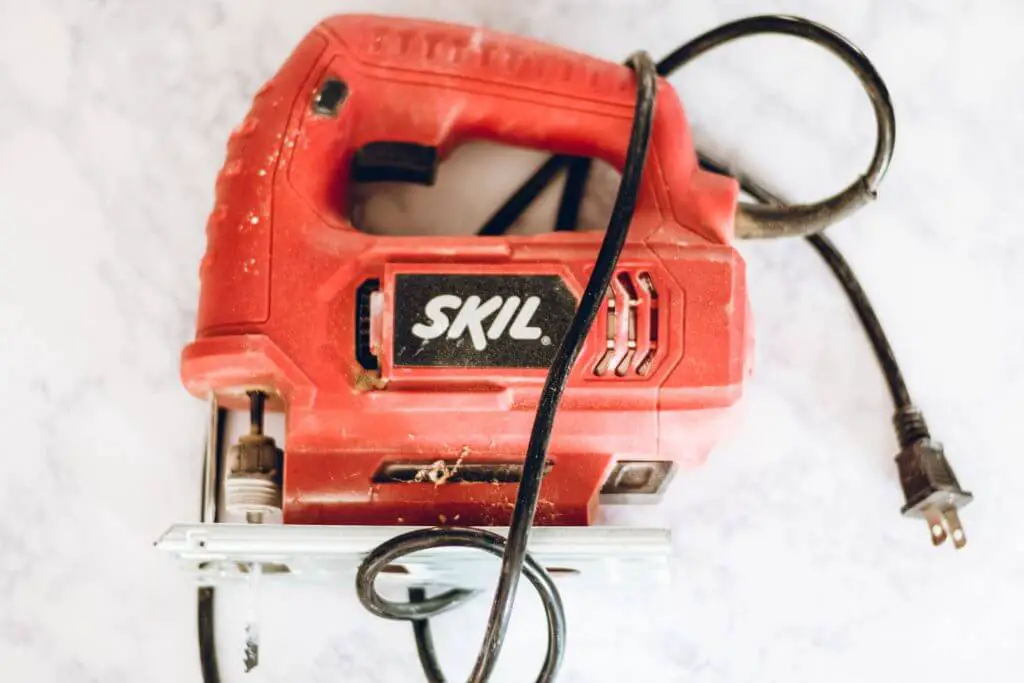
#6: Jigsaw
It might not be the first tool that comes to mind when thinking about cutting drywall, but it’s definitely one that I’ve reached for in the past.
When To Use A Jigsaw to Cut Drywall
If you need to cut complicated curved lines and don’t want to invest in a specialty tool like a spiral saw or Rotozip, a jigsaw is a great choice.
What To Look For In A Jigsaw Used To Cut Drywall
A jigsaw is a very versatile tool – it’s probably one of the most used in my collection. You’ll want to think about all the ways you can use a jigsaw before purchasing one. In other words, don’t buy it just to cut drywall…think about all the other uses too!
Here’s what you’ll want to look for in a great jigsaw:
- Cordless capabilites
- A tool that accepts T-Shank blades (they’re easier to change than U shaped blades)
- An LED on the front so you can easily see what you’re cutting
- An integrated dust blower can be really nice – jigsaws tend to produce quite a bit of dust!
I chose to go with the Ryobi Cordless Orbital Jig Saw (after the one pictured above died during a silicone caulk accident…don’t ask haha) because it’s a great price and works with my existing tools and batteries – but whatever you manufacturer you choose, you’ll be just fine. They all make fantastic jigsaws!
A quick note on blades: I’ve found the general purpose blades usually work the best – there aren’t really any specialty drywall blades out there. You want something that is aggressive enough to cut through the material, but not so aggressive that it tears up the drywall paper unecessarily.
How To Use A Jigsaw To Cut Drywall
Jigsaws are pretty intuitive to use, but I’ve found they’re best when starting from the edge of material, or within a pre-cut plunge hole – they don’t do plunge cuts very well. And start slow – remember, more speed isn’t better!
#7: Hole Saw Cutter
Hole saws are specailty tools – unless you’re making a TON of circular cuts, I would pick a different tool, especially for drywall where most circular cuts are going to be covered up anyway.
With that being said, if you’re a perfectionist (or just don’t trust your freehand circle cutting skills), hole saws can definitely come in handy.
When To Use A Hole Saw Cutter to Cut Drywall
Hole saws can only cut circles. If you need to cut a circle in drywall, great! This is a great tool. But if you need to cut a straight line, you’re out of luck.
I’d typically use a hole saw if I need to cut out drywall for a circular electrical box, but that’s pretty much it as a DIYer.
What To Look For In A Hole Saw Cutter Used To Cut Drywall
Hole saws can get pretty expensive – they’re usually sold in sets and range from about $50 to well over $200. And while you can certainly buy individual hole saws, I usually don’t think they’re worth the price since you can generally get so much more in a set for a similar cost.
Generally, the cheaper the set, the less variety you’ll have and smaller the hole saws will be in diameter.
- This 11 piece set will do everything from 1-3/8″ to 3″
- This 21 piece set will do everything from 3/4″ to 5″
I’d recommend investing in a larger set than you think you need – better to have too many than buy a smaller set and then have to buy extras one-by-one (which are more expensive and harder to store)
How To Use A Hole Saw Cutter To Cut Drywall
Hole saws can be tricky – and you pretty much get one chance. There’s usually a pilot bit in the center that you’ll use to guide the larger circular bit through the material.
Hole saws are one of those measure twice, cut once kind of tools.
Speaking from experience, if you go too small the first time, you’re going to have a LOT of trouble enlarging the hole since there’s no longer material for the pilot bit to guide the tool through.
Triple check your measurements beforehand and you’ll be MUCH happier with the result.
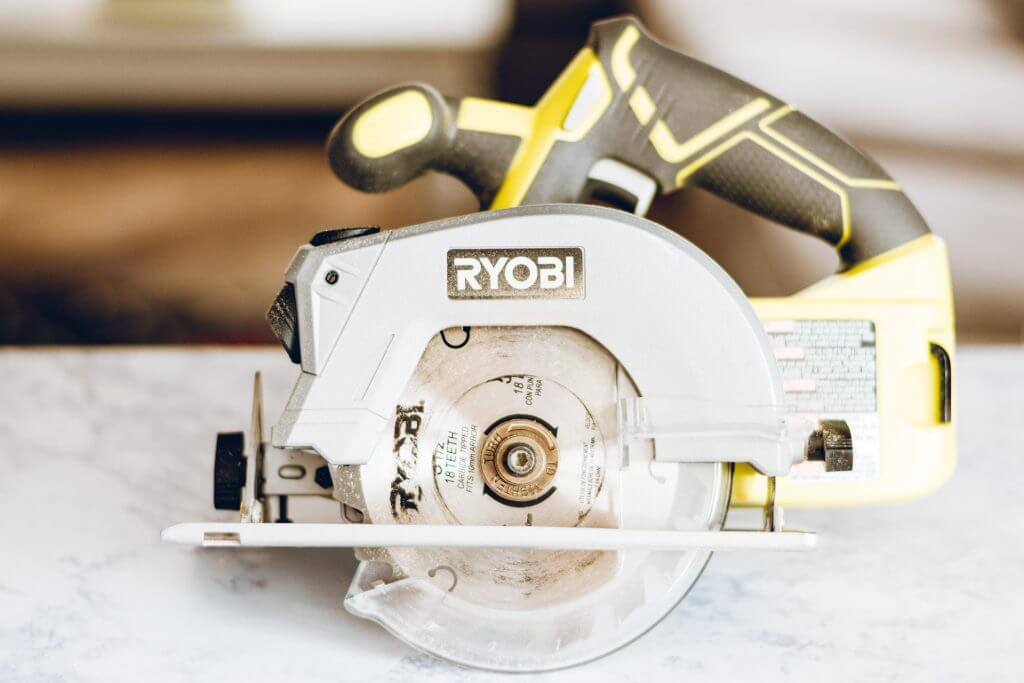
#8: Circular Saw
Circular saws are powerful tools – we usually think of them for cutting wood or plywood panels, but that doesn’t mean that you can’t use them to cut drywall.
With that being said, circular saws definitely shouldn’t be your first choice – using a circular saw to cut drywall will produce a TON of dust, and other tools can do it better. But, if it’s what you have on hand, it can certainly be done in a pinch.
When To Use A Circular Saw to Cut Drywall
Circular saws should really only be used to cut drywall if you have no other tools available. While yes, it can cut, it’s not going to give you a great result and the amount of dust created is unneccesary.
What To Look For In A Circular Saw Used To Cut Drywall
You’re not going to be able to find a specific drywall blade for your circular saw – no manufacturer is going to put one out because it’s just the wrong tool for the job. With that being said, I’d use a fine-finish blade if you HAVE to use a circular saw.
How To Use A Circular Saw To Cut Drywall
First, ask yourself if you have ANY other tools that can do the job – if so, use those. If not, forge ahead, but make sure you’re in a well-ventilated space and have lots of safety equipment and a stellar mask on.
Circular saws can only really cut straight lines, so measure and mark your board, and then slowly guide your circular saw along the cut. It can also be handy to use a piece of foam insulation underneath so you don’t have to use sawhorses (this tip actually works for cutting any sheet goods!).
How To Choose Which Drywall Tool Is Right For You
| Tool | Best Use Case |
|---|---|
| Utility Knife or Razor Knife | Small, straight cuts, but mostly used for scoring |
| Keyhole Saw, Compass Saw, Jab Saw, or Drywall Saw (Handheld Drywall Saws) | Just a few small, rough cuts |
| Oscillating Multitool | Large volume of small cuts, especially straight and plunge cuts, and when you’re in tight spaces |
| Reciprocating Saw | If you already own a reciprocating saw and need to make a large volume of rough cuts (just make sure to get the drywall blade!) |
| Spiral Saw or Rotozip | Professionals or really big DIY drywall jobs |
| Jigsaw | Curved cuts, or straight cuts if you use a guide |
| Hole Saw Cutter | Cutting circles – that’s pretty much it. You’ll need a drill to go with it. |
| Circular Saw | As a last resort – it’s overly messy and other tools can do the job better |
Are There Extra Safety Precautions Necessary for Cutting Drywall?
You will absolutely want to wear a great mask anytime you’re working with drywall – it’s one of the finest particles out there. So fine, in fact, that if you’re going to be doing drywall cleanup with a shopvac, you’ll need a specialty bag.
You don’t want gypsum dust in your lungs – wear a mask.
Here are a few that I would choose to wear:
- If you’re on a budget, these disposable masks work well! Just make sure you get a snug fit around your nose.
- If you want to ensure a great fit and have a little more to spend, a respirator like this is a great investment.
If you can, also think about picking up some safety goggles. Drywall dust is microscopic, and can easily get into your eyes. Even though they still fog up a bit, I like these – I feel very well protected and know nothing is going to get into my eyes.
How Do You Hang Drywall?
Before you hang any of your drywall, you want to make sure that the power to any electrical boxes you’ll be near is turned off.
After you’ve cut your drywall to size and cut out any spots for lights or outlets using the methods listed above, attach the sheets of drywall to the studs and framing of your walls with drywall screws.
To conceal the seams that pop up in between the sheets of drywall, you’ll want to spread joint compound or joint tape to bridge the gap. You can also use these materials to fill in any defects or imperfections you notice in the drywall sheets.
To have a more streamlined look to your drywall, you might opt for giving ALL of the drywall sheets, as well as the gaps in between them, a skim coat of joint compound. This can help hide the visual differences between the bare paper drywall and the areas in which you’ve had to apply joint compound.

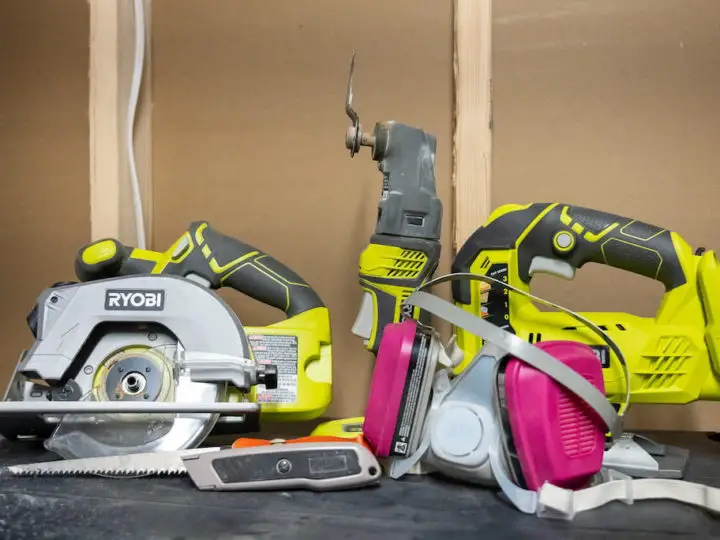
imtiajrafid
Tuesday 15th of August 2023
this post is very informative.
Steve
Saturday 3rd of September 2022
Wow! Awesome collection of information! Thank you!
Ashlyn
Monday 19th of December 2022
Thank you for such a detailed article, and including the attachments with items you personally use. Finding talented dry wallers for custom residential projects is always a challenge. Wish we had someone like you in Scottsdale!